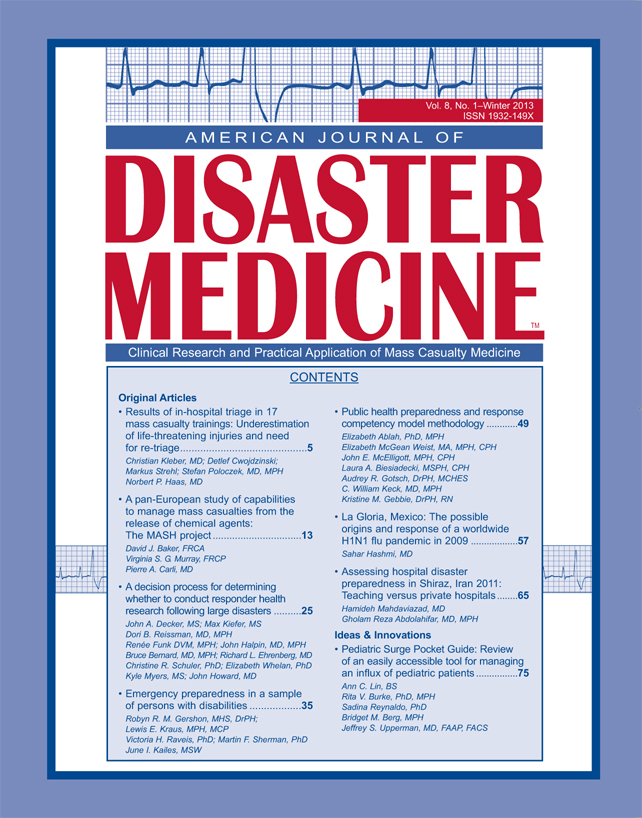A pan-European study of capabilities to manage mass casualties from the release of chemical agents: The MASH project
DOI:
https://doi.org/10.5055/ajdm.2013.0107Keywords:
MASH, European, mass, chemical, casualty, managementAbstract
The European Union (EU) Mass Casualties and Health (MASH) project that ran between 2008 and 2010 was designed to study the management of mass casualties from chemical and radiological releases and associated health implications. One area of study for this project concerned arrangements within EU Member States for the management of mass casualties following a chemical release. This was undertaken via a confidential online questionnaire that was sent to selected points of contact throughout the EU. Responses were obtained from 18 states from respondents holding senior positions in chemical planning and incident response. Information gathered shows a lack of uniformity within the EU about the organization of responses to chemical releases and the provision of medical care. This article presents the overall findings of the study demonstrating differences between countries on planning and organization, decontamination, prehospital emergency medical responses, clinical diagnoses, and therapy and aftercare. Although there may be an understandable reluctance from national respondents to share information on security and other grounds, the findings, nevertheless, revealed substantial differences between current planning and operational responses within the EU states for the management of mass chemical casualties. The existing international networks for response to radiation incidents are not yet matched by equivalent networks for chemical responses yet sufficient information was available from the study to identify potential deficiencies, identify common casualty management pathways, and to make recommendations for future operations within the EU. Improvements in awareness and training and the application of modern information and communications will help to remedy this situation. Specialized advanced life support and other medical care for chemical casualties appear lacking in some countries. A program of specialized training and action are required to apply the findings revealed by the MASH study into a unified cross-border emergency medical response.References
Schaper A, Desel H,Wyke S, et al.: Countering health threats by chemicals with a potential terrorist background—Creating a rapid alert system for Europe. Eur J Intern Med. 2012;23(2): e63-e66.
Murray VSG, Baker DJ: Chemical incidents. In Greaves I, Porter K, Smith S (eds.): Practical Prehospital Care: The Principles of Immediate Care. Churchill Livingstone, London: Elsevier, 2011: 503-513.
Baker DJ: Civilian exposure to toxic agents: the emergency medical response. Prehosp Disast Med. 2004; 19(2): 157-161.
Anon: Calamity at Bhopal. Lancet. 1984; 137: 1378-1379.
Baker DJ: The anesthesiologist and chemical and biological weapons. In Miller R (ed.): A Textbook of Anesthesia, 7th ed. St Louis, MI: Elsevier, 2008: Chapter 72.
Council of the European Union: Conclusions on preparedness and response in the event of a CBRN attack, 2010. Available at www.consilium.europa.eu/uedocs/cms_data/docs/ . . . /117556.pdf. Accessed August 2, 2011.
Baker D,Watson S, Holmes S, et al.: Mass Casualties and Health following the release of toxic chemicals and radioactive material (MASH). Available at www.hpa.org.uk/Publications/Radiation/.../rad006miscpubMASH/. Accessed February 5, 2013.
UK Health Protection Agency: Mass Casualties from chemical and radiological agent release: Foresight into needs, possibilities and information requirements for the future. Available at www.hpa.org.uk/web/HPAwebFile/HPAweb_C/1296682119753. Accessed October 6, 2011.
Anon: Circulaire 700 SGDN/PSE/PPS (November 7, 2008). Relative a la docrine nationale d’emploi des moyens et de soins face a une action terroriste mettant en úuvre des matieres chimiques (in French). Available at www.sante.gouv.fr/un-plan-pour-les-risquesnrbc.html. Accessed December 28, 2011.
Okumura T, Nomura T, Suzuki T, et al.: The dark morning: The experiences and lessons learned from the Tokyo Subway Sarin attack. In Marrs T, Maynard R, Sidell F (eds.): Chemical Warfare Agents: Toxicology and Treatment, 2nd ed, Chapter 13. Chichester, UK: John Wiley and Sons, Ltd, 2007: 277-286.
Maynard R: Opinions of chemical warfare. In Marrs T, Maynard R, Sidell F (eds.): Chemical Warfare Agents:Toxicology and Treatment, 2nd ed, Chapter 1. Chichester, UK: John Wiley and Sons, Ltd, 2007: 1-20.
Prentiss A: Chemicals in War.New York,NY:McGraw Hill Inc., 1937.
EU, 2002: Protection of citizens in the event of a terrorist attack: Commission announces large-scale European simulation exercise (EURATOX 2002).Available at http://europa.eu/rapid/pressReleasesAction.do?reference=IP/02/1498&forma=HTML&aged=1&language=EN&guiLanguage=fr. Accessed November 9, 2011.
Council of the European Union: EU project HESCULAEP. Available at http://www.hesculaep.org. Accessed August 2, 2011.
Council of the European Union: EU REACH project/. Available at http://www.intertek.com/reach. Accessed August 2, 2011.
Baker DJ,Telion C, Carli P: Multiple casualty incidents: The prehospital role of the anesthesiologist in Europe. Anesthesiol Clin. 2007; 25(1): 179-188.
Anon: The UK HART system. Available at http://www.ambulancehart.org.uk. Accessed August 2, 2011.
Baker DJ: Management of respiratory failure in toxic disasters. Resuscitation. 1999; 42(2): 125-131.
Anon: Plan Biotox—An introduction (in French). Available at http://www.sante.gouv.fr/htm/dossiers/biotox.into.htm. Accessed December 28, 2011.
Rojas-Palma C, Liland A, Næss Jerstad A, et al. (eds.): TMT Handbook, Triage, Monitoring and Treatment of People Exposed to Ionizing Radiation Following a Malevolent Act. Didcot, UK: NRPA, 2009.
Published
How to Cite
Issue
Section
License
Copyright 2007-2023, Weston Medical Publishing, LLC
All Rights Reserved


